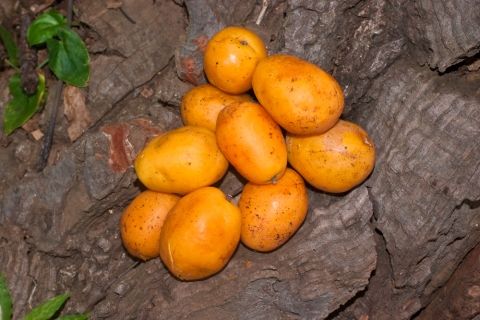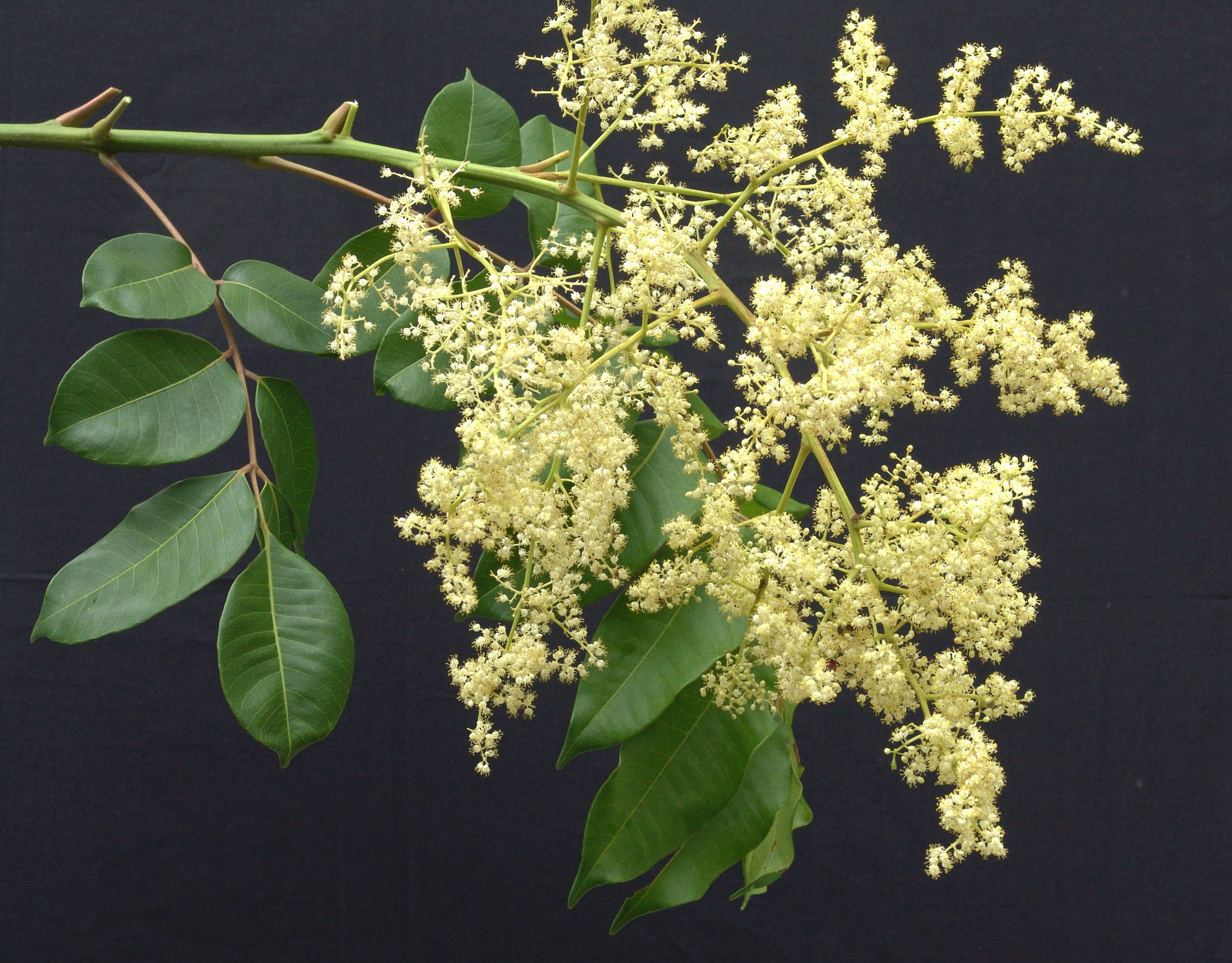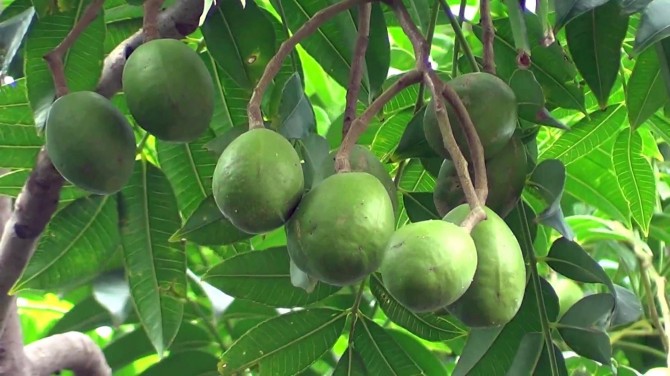Spondias mombin L.
| Botanical Name | Spondias mombin L. |
| Order: | Sapindales |
| Family: | Anacardiaceae |
| Genus: | Spondias |
| Species: | S. mombin |
| Common Names: | English: Hog plum (English), Mombin, Prune mombin ou Prune Myrobolan (French) |
Plant Synonyms
Spondias aurantiaca Schum & Thonn, Spondias brasiliensis Mart, Spondias lucida Salisd., Spondias iulea T, Spondias myrobalanus L, Spondias oghibee G. Don, Spondias pseudomyrobaianus L.Tuss, Mauria juglandifoiia Benth, Myrobalanus iutea Maef
Plant Local Names
Burkina Faso: Dioula - Mingo; Minkon, Fulfulde - Tale;tali
Cote d'lvoire: Abe – Ngba
Ghana: Twi - Atoaa
Mali: Barbara - Minko Mingo Ninkom, Peul - Tale tali, Dogon - Enye vevey
Nigeria: Yoruba - Agliko
Senegal: Wolof - Sob ninkom, Serer - Yoga, Diola- Bu lila Bu lilu
Togo: Ewe - Akoukonti, Adja - Kukon, Adele - Inyanya
Plant Habitat
The plant is native to the tropical Americas, including the West Indies, but has been naturalized in parts of Africa, India and Indonesia. It is rarely cultivated. It grows well in warm climates and in a wide variety of soils: sandy soil over shallow gravel or in a heavy clayey soil.
Plant Material of Interest
Stem bark and leaf, Root, flower, fruit
Plant Description
A tree that grows from 15 to 25 m high with a clear bark, streaked, cracked, rough and thick; bark is usually covered with large spines and exudes resin upon injury; drum thickened at the base, reaching about 0.75 m in diameter; branches are flared and the foliage is full and balanced; leaves are compound, odd-pinnate, measuring 50 cm long with 5-8 pairs of leaflets 7 cm long and 3.5 cm wide, unequal at the base shortly acuminate, short rib at the edge of the lamina uniting the lateral veins; small white flowers, fragrant with large terminal panicles appearing during the dry season defoliation; inflorescences are arranged in terminal panicles, pyramidal, 20 to 40 cm long, covered with short hairs mainly; fruit is a sweet astringent plum; pulpit more or less acidic and pleasant, have ovoid drupes from 2.5 to 4 cm long and 2 to 2.5 cm wide.
Plant Used Parts
Plant Uses
In Mali, the plant is used to treat tooth decay; it is also used as a diuretic, laxative and purgative and febrifuge (Adjanohoun et at., 1979). The leaf extracts have potent antimicrobial and antifungal properties. The juice obtained by expression of the fresh leaves is commonly used in Senegal for the treatment of eye diseases, while the leaf or root bud decoction is prescribed for diarrhoea and dysentery or macerated for colic pain (Kerharo and Adam, 1974). The decoction of the leaves with added salt has diuretic and laxative properties (Adjanohoun et at, 1979). The leaf decoction is also a remedy for caries, dental abscesses, colic, various eye diseases and toothache (Boullard, 2001). The bark infusion is used as a mouthwash against toothache and as an anthelmintic; the decoction of the bark is used in cough with severe inflammatory symptoms, and vomiting. The dried bark is used as a spray on fresh wounds of circumcision and the stem bark is used as a tea for pregnant women (Boullard, 2001).
Plant Therapeutic Action
Broad spectrum antiseptic and antibacterial, abortifacient, anthelmintic, anticarcinogenic, anticonvulsant, antidopaminergic, antifungal, antioxidant, antispasmodic, antiviral, anxiolytic, cytotoxic, smooth muscle relaxant, haemostatic, sedative, uterine stimulant, nervine.
Plant Precaution for Use
Should not be used at high doses. Regularl monitor of blood glucose, hepatic and renal biochemical parameters on prolonged use at low doses. Should not be combined with other hypoglycaemic drugs except under medical supervision.
Plant Adverse Effect
Fruit is acidic and renders the teeth and tongue sharply sour
Plant Contraindication
Pregnancy and gastric ulceration
Plant Dosage Forms
Infusions; decoction; tincture
Plant Dosage
Infusion: about 25 g per day
Tincture: 1:5, 90% alcohol 0.3-1.2 ml, max 25 ml per week
Plant Storage
Store in a cool dry place
Plant Chromatographic Fingerprint
Plant Constituents
Tannins, palmitic, linoleic, oleic, stearic, linolenic acids, flavonoids (quercetin, quercetrin, rutin, and their. 7-O-glucosides); saponin, sugars; alkaloids, proanthocyanins (condensed tannins) Allo-liydroxycitnc arid ondias mombin
Plant References
Abo, K. A., Ogunleye, V.O., Ashidi, J.S. (1999). Antimicrobial potential of Spondias mombin, Croton zambesicus and Zygotritonia crocea Phytotherapy Research 13(6):494-497.
Ademola, I.O., Fagbemi, B.O., Idowu, S.0.(2005). Anthelmintic activity of extracts of Spondias mombin against gastrointestinal nematodes of sheep: studies in vitro and in vivo. Tropical Animal Health and Production 37(3):223-235.
Adjartohoun, E.J., Ake Assit, L., Floret, J.J., Guinko, S., Koumare M. et al. (1979). Medecine traditionneile (MT) et pharmacopee, contribution aux etudes ethnobotaniques et floristiques au Mali. ACCT. Paris; 27, 33 p.
Amadi, E.S., Oyeka, A., Onyeagba, R.A., Okoli, I., Ugbogu, O.C. (2007). Studies on the antimicrobial effects of Spondias mombin and Baphia nittida on dental caries organism. Pakistani Journal of Biological Science 10(3):393-397.
Apori, S.O., Castro, F.B., Shand, W.J., Orskov, E.R. (1998). Chemical composition, in sacco degradation and in vitro gas production of some Ghanaian browse plants. Animal Feed Science and Technology 76(1 -2): 129-138.
Ayoka, A.O., Akomolafe, R.O., Iwalewa, E.O., Akanmu, M.A., Ukponmwan, O.E. (2006). Sedative, antiepileptic and antipsychotic effects of Spondias mombin L. (Anacardiaceae) in mice and rats. Journal of Ethnopharmacology 103(2):166-175.
Ayoka, A.O., Akomolafe, R.O., Iwalewa E.O., Ukponmwan, O. E. (2005). Studies on the anxiolytic effect of Spondias mombin L. (Anacardiaceae) extracts. African Journal of Traditional, Complimentary and Alternative Medicine 2(2): 153-165.
Boullard, B. (2001). Dictionnaire des plantes medicinales du monde. Realites et croyances. 25, 113, 249,357, 374, 532 p.



